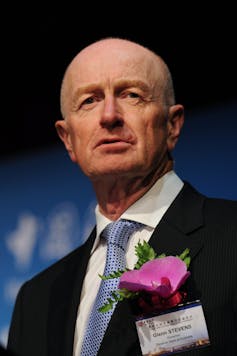The Westpac Melbourne Institute Index of Consumer Sentiment reveals consumer confidence dropped by 1.2% in March, following an 8% rise in the index the previous month - which, in turn, followed a substantial fall in December. The ANZ-Roy Morgan Consumer Confidence Index], released yesterday, told a similar story: confidence is about one percent lower than last month.
The Australian Chamber of Commerce and Industry’s most recent quarterly report on investor confidence, released last December, indicated that businesses at that time were pessimistic about the state of the economy. More recent data suggests that business-people remain concerned: the latest National Australia Bank’s Monthly Business Survey showed business confidence at its lowest level since mid-2013, while the Roy Morgan Business Confidence Index likewise fell substantially.
If the world of business, economics, and finance were governed purely by logic and dispassionate quantitative analysis, there would be little interest in variables such as consumer sentiment and investor confidence. But people do not always behave dispassionately and logically. Their emotions and their beliefs - founded or unfounded - affect the decisions that they make; these decisions in turn influence economic performance and prosperity. Because of this, economists and policymakers pay considerable attention to measures of consumer and investor confidence.
Measuring people’s state of mind
Confidence measures are different from most economic data because they place a number on an amorphous psychological variable. They seek to quantify not the value of observable economic transactions, but people’s states of mind. It is conceivable that such measurements could be nothing but “noise” - random opinions that are unrelated to behaviour or to the actual state of the economy - in which case they would be irrelevant for our economic understanding. But this turns out not to be true: confidence measures do help explain actual economic behaviour.
When consumers feel confident about the state of the economy, they believe (on average) that they have secure job prospects, that they are more likely to see wage increases, and that their wealth (in the form of, say, share market holdings) is likely to go up. Such factors tip consumers towards spending rather than saving. Likewise, if businesses feel confident about the prospects for sales, they are more likely to undertake new capital expenditures and hire workers.
An economy where consumers are buying and businesses are investing is an economy that is likely to be booming, because it is the level of spending that drives the level of activity in the economy in the short run. An economy where confidence is low, conversely, is one when consumers and businesspeople are likely to be cautious, resulting in lower spending and depressed economic activity.
Of course, changes in confidence don’t occur in a vacuum. They respond to the news that people read and watch, to the conversations that they have with their friends, and to their own personal experiences of how the economy is performing.
Researchers have tried to identify the extent to which changes in confidence can be explained by the arrival of economic news (unemployment reports, stock market changes, and so on). If confidence measures just summarise other news that is already available, then they are less interesting. But if confidence measures tell us something about the economy above and beyond what we might learn from other sources, then they are of much greater significance. Among other things, confidence measures then become more likely to help us forecast the future direction of the economy.

The wisdom of many - or animal spirits?
In a sense, these measures are an attempt to tap into the wisdom of crowds. Because individuals live in the economy, they have direct and immediate information on how their little piece of the economy is performing - information that may not be immediately (or ever) available to government statisticians. If consumers and managers have good reasons for their confidence in the economy - or their lack of it - then measures of sentiment should contain information about where the economy is heading.
And indeed, research on confidence measures suggests that they do reflect market participants’ knowledge of what is likely to happen in the future, in addition to available information on the current state of the economy. Confidence measures are therefore helpful for predicting future economic performance.
But there may be even more going on. Perhaps these measures reflect more than current news and people’s tacit understanding of the future. A long tradition in economics asks whether economic behaviour is driven not just by calculation and rational decision, but also by unpredictable whim. John Maynard Keynes, in particular, thought such “animal spirits” were a key source of economic instability:
“… there is the instability due to the characteristic of human nature that a large proportion of our positive activities depend on spontaneous optimism … if the animal spirits are dimmed and the spontaneous optimism falters, leaving us to depend on nothing but a mathematical expectation, enterprise will fade and die.” (J.M. Keynes, The General Theory of Employment, Interest and Money, New York: Harcourt, Brace & World, 1936, p. 162)
Consumer and investor confidence measures, in this view, also reflect waves of optimism or pessimism that do not have a obvious rational basis, and that cannot be understood either in terms of current news or available information about future economic performance.
We do not really know for sure how important such effects may be. In part this is because, intriguingly, beliefs can have an element of self-fulfilling prophecy. If consumers and businesspeople are pessimistic about the state the economy, then consumption and investment spending fall, and economic performance suffers, validating the pessimistic expectations. Conversely, optimism about the state of the economy can lead to higher spending that results in higher economic growth, justifying the initial optimism. In such a world, there may be no obvious basis for a change in consumer or investor sentiment, and yet that change in beliefs can turn out to be rational after the fact.
Bad news bears
So what does all this mean for the Australian economy? Confidence certainly matters in Australia, just as it does in other economies. Research conducted at the Melbourne Institute by Viet Nguyen and Edda Claus suggests that bad news, in particular, influences confidence and consumption in Australia.
This finding was echoed by Warren Hogan, Chief Economist at ANZ in his comments on the recent ANZ-Roy Morgan confidence measures. Consumers, Morgan notes, “continue to show an asymmetric response to newsflow. Over the last year or so, there have been sizable declines in consumer confidence in relation to any negative news around the Federal budget and economy”. Recent confidence numbers are not so low as to be alarming, but it is fair to say that the measures are starting to show a pattern of warning signals for the Australian economy.

Given that confidence is affected by economic news, it is also affected by economic policies. When the Reserve Bank of Australia cut interest rates last month, its primary aim was to encourage interest-sensitive components of spending, such as firm’s capital expenditures and households’ purchases of durable goods. But the RBA undoubtedly hoped that this decision would help to spur confidence in the economy as well.
A case can be made that this was one reason that Australia made it through the global financial crisis relatively unscathed: aggressive action on both monetary and fiscal policy may have helped restore the confidence levels of Australian consumers and investors. Even though confidence levels fell substantially in 2008, they had recovered to pre-crisis levels by mid-2009. (Compare this with the United States, which did not get back to the level of confidence of January 2008 until the middle of 2012.)
Yet this can be a double-edged sword. When Australians observe the Reserve Bank moving to cut interest rates and stating that “further easing of policy may be appropriate over the period ahead”, they might react in different ways. Do these actions and words make them more nervous (“the RBA must think there is a problem with the economy, or else they wouldn’t be cutting rates”) or more confident (“the RBA is clearly on top of things, and the interest rate cut will lead to faster growth”)?
Economics is not just a matter of rational financial calculation; psychological variables matter as well. Consumer and investor confidence are therefore more than simply variables that policymakers must factor into their decisions. They are themselves targets of economic policy.

